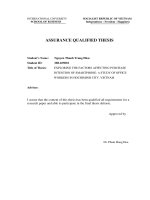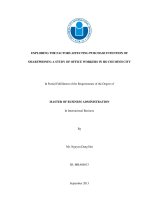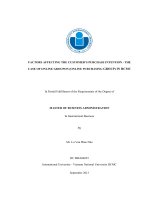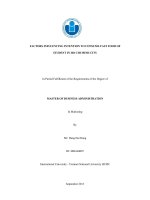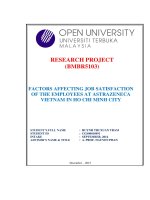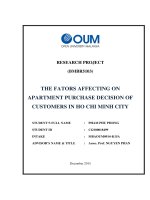Factors affecting the consumer purchase intention of laptop in ho chi minh city
Bạn đang xem bản rút gọn của tài liệu. Xem và tải ngay bản đầy đủ của tài liệu tại đây (780.76 KB, 73 trang )
UNIVERSITY OF ECONOMICS HO CHI MINH CITY
International School of Business
------------------------------
VO MINH HUNG
Assoc. Professor Le Nguyen Hau
FACTORS AFFECTING THE CONSUMER PURCHASE INTENTION OF
LAPTOP IN HO CHI MINH CITY
MASTER OF BUSINESS (Honours)
1
Acknowledgement
I would like to express my sincere gratitude to my supervisor, Assoc. Professor Le
Nguyen Hau for the valuable supervision, the support and encouragement he gave me.
I would like to express my gratitude to my ISB class friends for SPPS directions.
Your encouragement, excellent guidance, and critical comments have greatly contributed
to this thesis.
Finally, I would like to thank all of the respondents without whom, this research
would have been impossible.
Vo Minh Hung
Febuary 2014
2
Abstract
Nowadays, laptop has dramatically become a part of life tool for people around the
world, especially for young adult. They use laptop to communicate with people,
download songs and games, texting message and so on. Laptop has the ability to
provides, obtain, and shares personal and social information. Through these benefits,
young adults can create visual form of communication method, update their status in
time, and interacted with each other in anytime and anywhere. Laptop also provided the
capabilities of integrating wireless connections, 3G.
Although the demand of young adults towards laptop in market is high, there is
still a slow growth of market demand in certain area. The motivation of young adults to
adopt a laptop in Vietnam is slightly lower than neighbor country, such as Indonesia,
Thailand and Malaysia. Indonesia, Thailand and Malaysia are the three biggest markets
for such gadgets and collectively consume over 70 percent of the region‟s sales volume
while contributing 67 percent to the overall dollar value (RickMartin 2012). Laptop firm
does not have better understanding the preferences of consumer to own a laptop. Firms
will face the difficulty of fast growth on the business and difficulty to expand business.
The main purpose of this research is to explore the factors affecting purchase
intention of laptop in Vietnam. Researchers have identified four factors that affecting
purchase intention of laptop during this research, which included relative advantages,
price, social influence, compatibility. Throughout this research, firms may have a better
understanding on the intention to purchase a laptop. This coming research will use
3
quantitative research method, conducted from surveying of laptop purchasers in Ho Chi
Minh City
Key words: Intention, Laptop, Relative Advantages, Price, Social Influence,
Compatibility.
4
Table of Contents
Abstract………………….………………………………………………………………..3
Table of Content………………………………………………………………………….5
Table of Figure…………………………………………………………...………………8
Table of Table……………………………………………………………………………9
1.1. Research Background .............................................................................................................10
1.2. Research Problem ...................................................................................................................11
1.3. Research Objectives ................................................................................................................12
1.4. Scope of the research ..............................................................................................................12
1.5. Significance of the Study ........................................................................................................12
1.6. Structure of the Thesis ............................................................................................................13
2.1. Literature Review....................................................................................................................14
2.1.1. Purchase Intention ...................................................................................................... 14
2.1.2. Antecedents of purchase intention ............................................................................. 16
2.1.2.1. Price ............................................................................................................... 16
2.1.2.2. Compatibility ................................................................................................. 16
2.1.2.3. Relative Advantage ....................................................................................... 17
2.1.2.4. Social influences............................................................................................ 18
2.2. Development of Research Hypotheses ...................................................................................19
2.2.1. Relationship between Price and Purchase Intension .................................................. 19
2.2.2. Relationship between relative advantage, compatibility and Purchase Intension ...... 20
5
2.2.3. Relationship between Social Influences and Purchase Intension............................... 20
2.3. Research Model and Hypothesis .............................................................................................22
2.4. Conclusion ..............................................................................................................................23
3.1. Procedure ................................................................................................................................24
3.2. Data Collection Methods ........................................................................................................26
3.3. Sample Design ........................................................................................................................26
3.3.1. Target Population ....................................................................................................... 26
3.3.2. Sample Size ................................................................................................................ 27
3.4. Questionnaire design ...............................................................................................................28
3.4.1. Section A .................................................................................................................... 28
3.4.2. Section B .................................................................................................................... 29
3.5. Measurement ...........................................................................................................................33
3.5.1. Data Processing .......................................................................................................... 33
3.5.2. Data Analysis Technique ........................................................................................... 34
3.5.2.1. Reliability ...................................................................................................... 34
3.5.2.2. Exploratory Factor Analysis (EFA)............................................................... 35
3.5.2.3. Multiple Regression Analysis........................................................................ 35
3.6. Conclusion ..............................................................................................................................35
4.1. Descriptive Analysis ...............................................................................................................36
4.2. Reliability Test ........................................................................................................................38
4.3. Exploratory Factor Analysis (EFA) ........................................................................................39
4.4. Multiple Regression Analysis .................................................................................................41
4.4.1. Assumption: Homoscedasticity of residuals .............................................................. 41
6
4.4.2. Assumption: No multicollinearity .............................................................................. 41
4.4.3. Multiple Regression ................................................................................................... 43
4.4.4. Hypothesis Testing ..................................................................................................... 45
4.5. Conclusion ..............................................................................................................................47
5.1. Key Findings ...........................................................................................................................48
5.1.1. Relationship between relative advantage and purchase intention .............................. 49
5.1.2. Relationship between price and purchase intention ................................................... 50
5.1.3. Relationship between compatibility and purchase intention ...................................... 50
5.1.4. Relationship between social influence and purchase intention .................................. 51
5.2. Implication ..............................................................................................................................51
5.3. Limitation of the Study ...........................................................................................................52
5.4. Recommendations for Future Research ..................................................................................52
5.5. Conclusion ..............................................................................................................................53
7
Table of Figures
Figure 2.3: The research model and hypotheses............................................................... 22
Figure 3.1: Research process............................................................................................ 25
8
Table of Tables
Table 3.4.2: Survey item summary................................................................................. 29
Table 4.1.1: Gender........................................................................................................ 37
Table 4.1.2: Race............................................................................................................ 37
Table 4.1.3: Spending Monthly...................................................................................... 37
Table 4.2: Result of Reliability Test.............................................................................. 38
Table 4.3.1: KMO of Indepent Variable........................................................................ 39
Table 4.3.2: KMO of Depent Variable.......................................................................... 39
Table 4.3.3: Rotated Component Matrix of Indepent Variable..................................... 40
Table 4.4.2a: Correlations............................................................................................. 41
Table 4.4.2b: Coefficients............................................................................................. 42
Table 4.3.3a: Model Summary...................................................................................... 43
Table 4.3.3b: ANOVA.................................................................................................. 43
Table 4.3.3c: COEFFICIENTS..................................................................................... 44
Table 5.1 Research result.............................................................................................. 48
9
CHAPTER 1: INTRODUCTION
The research explores the factors affecting purchase intention of laptop of users in
Ho Chi Minh City, Vietnam. This chapter includes research background, research
problem, research objective, and significance of the study.
1.1. Research Background
Most of the personal computers nowadays are laptops, because they are easier to
carry and more connectivity than a desktop computer. Laptop technology, with its
utilities and powerful functionality, is inevitably changing peoples‟ behaviors; especially
young adults using laptop frequently today. CourseSmart, which is the world„s largest
provider of digital course materials and eTextbooks, found that university students can„t
go long without checking their digital devices, including smartphone, laptop and more
(CourseSmart, 2011)..
It‟s very common to see university students and adults checking Facebook status,
check email or other social network sites using laptop with their constant web connection
feature nowadays. Almost, students and adults have laptop. Therefore, consumers are
keeping themselves with high concern with technologies might change their devices from
time to time. In other words, devices can be easily be replaced due to the fast pace of
advancement in technology. Hence, it is essential to know that what factors that actually
affecting purchase intention of laptop among the adults in Vietnam.
10
1.2. Research Problem
Laptop„s demand has been increasing nowadays in worldwide typically in Western
countries. The markets for laptops and tablets in Southeast Asian regions are seeing a
surge in demand and growth (RickMartin 2012). However, the adoption rate of laptop in
Vietnam is still slow comparing to other nations in South-East Asia such as such as
Indonesia, Thailand and Malaysia (RickMartin 2012). In Vietnam, there are 91.5 million
of populations which are more than Thailand (67.1 million of populations) and Malaysia
(29.1 million of populations) but Indonesia, Thailand and Malaysia are the three biggest
markets for laptops and tablets consume over 70 percentage of the region‟s sales volume.
In Vietnam, using the web by desktop PC is 80 percent. Using the web by
laptop/notebook is 16 percentages. Other digital devices are 4 percentages (Wayne,
2012).
Although most of the laptop users in Vietnam are younger consumers, but the
motivation to adopt laptop among young adults in Vietnam toward laptop is very low,
which mean that not all consumers would like to purchase a laptop or change from
desktop computer to laptop. According to the problem occurred, the research clearly
identify that laptop is getting popular among customers in other countries but not so
successful in Vietnam.
The problem is the motivation for consumers in Vietnam to purchase laptop is
very low. In order to solve this problem, the research clearly identify that the factors
affect purchase intension of laptop in Vietnam. The research identifies why users in
11
Vietnam doesn't use much laptop and need to understand their purchase intention.
1.3. Research Objectives
The main objectives of this research are to investigate the influence of key factors
that affect purchase intention of laptops in Vietnam.
The research investigates the impact of social influence, relative advantages,
compatibility and price on purchase intention of laptop of users in Ho Chi Minh City,
Vietnam.
1.4. Scope of the research
The research was narrowed down to Ho Chi Minh city, Vietnam. Particularly, data
were only collected at University of Economics Ho Chi Minh city. This research has four
independent variables: relative advantage, price, compatibility and social influence.
1.5. Significance of the Study
This study significantly provides for the firms to understand better on the factors
that affect purchase intention of laptop in Vietnam. Laptop firms may gain information
about the factors that cause consumer to request a laptop and understand the features of
laptop that request by consumer such as design, colors, application and also price setting.
The firms can have a better strategies planning with an accurate information and
certainty on consumer. Understanding the factors that have influenced their purchase
12
intention, future researchers or laptop companies in Vietnam can refer to this research to
understand more what users in Vietnam think,
This research may benefit the firm on understanding how does consumer to
perceive the product via knowledge, past experience of using similar product, value,
belief, and need (Lewis, 2012). The more the innovation is perceived to be consistent
with existing procedures, belief and value systems, the greater the chances are for its
adoption (Brummans, 2006). Consumers will have a positive perception towards product
as the firms have make it to fulfill market demand, as the product is giving a lot of
benefits.
1.6. Structure of the Thesis
The structure of this research report consists of five chapters. Chapter 1 introduces
the overview of the research topic. Chapter 2 presents the theoretical basis, theoretical
modeling with the proposed hypothesis. Chapter 3 presents the research methodology to
test the scale and theoretical models offered. Chapter 4 presents the results of the
implementation of the testing and analysis of information and data from which to draw
conclusions for the research hypotheses proposed in Chapter 2. Chapter 5 summarizes the
main results of the study, and also mentioned the limitations of research.
13
CHAPTER 2: LITERATURE REVIEW AND HYPOTHESES
This chapter includes the literature review and following by research model and
hypotheses. Initially, existing literature to understand and identified existing trends and
relationships among variables, in order to generate new ideas has been reviewed.
Afterward, dependent and independents variables based on the existing literature were
defined. By referring relevant theoretical models, construction of research model has
been done. Lastly, the hypothesis for verification of theory has been formulated.
2.1. Literature Review
2.1.1. Purchase Intention
Purchase intention can be defined as an advance plan to purchase certain good or
service in future, this plan may not always lead to implementation, because it affected by
ability to perform (Warshaw & Davis, 1985). In other words, what the consumer think
and will buy in their mind represents the purchase intention (Blackwell, Miniard &
Engel, 2001). Besides that, purchase intention can also determine the possibility of a
consumer lead to purchase action, through identify the intensity of purchase intention,
there is a high possibility to purchase particular product when the purchase intention is
stronger (Dodds, Monroe & Grewal, 1991, Schiffman & Kanuk, 2000). Purchase
intention shows that consumers will follow need recognition, information search through
external environment, evaluation of alternatives, make purchase decision and post14
purchase experience (Zeithaml, 1988, Dodds, Monroe & Grewal, 1991, Schiffman &
Kanuk, 2000). Furthermore, consumers‟ perception on relative advantage of laptop and
efforts required to obtain a laptop have significant influence on purchase intention. The
effort required to obtain a laptop includes price, search time, availability and so on.
Perceived value is one of the factors may trigger the purchase intention, the perceived
value come from the relative advantage and product compatibility as compared to efforts
needed to obtain a product, the efforts can be product price and search time, the greater
perceived value is, the greater possibility leading to purchase intention and purchase
action (Monroe & Krishnan, 1985, Zeithaml, 1988). Moreover, purchase intention also
treated as metric for prediction of consumer purchasing behavior (Bonnie, Teresa,
Yingjiao & Raul, 2007). Besides that, the intention to purchase is known as consumers'
tendency to behave on an object; it usually measured in terms of intention to buy (Kim &
Kim, 2004). The idea of intention to purchase toward particular products or services is
the final cognitive step in the decision making process of purchase intention, this
statement agreed by most of the past researchers (Agarwal & Teas, 2002, Erevelles,
1993, Fishbein, 1967, Han, 1990, Pecotich, Pressley, & Roth, 1996). In additional,
marketers are interested to purchase intention, because it can help them in market
segmentation and support their decision making like where the product should be launch
(Sewall, 1978, Silk & Urban, 1978). Other than that, purchase intention can be used for
future demand prediction too (Armstrong, Morwitz, & Kumar, 2000). Lastly, there are
15
positive relationships between relative advantage, price, social influence and product
compatibility with purchase intention (Joep, Ruud, & Tammo, 2011).
2.1.2. Antecedents of purchase intention
2.1.2.1. Price
Price is one of the most important cues in marketplace. The economics and
consumers elements can be used to interpret the view about price. Price is represented as
constraint to be trade-off products for each unit with maximum utility from economics
perspective. No hidden information exists in exchanging products in marketplace. The
issue of price has been discussed as critical factor requiring consideration with limited
budget on purchase intention (Erickson & Johansson, 1985). Purchase intention tends to
be reduced when the actual price on products is higher than acceptable price range and
vice versa (Dodds, Monroe, & Grewal, 1991). If the price is lower than acceptable price
range seriously, consumers are lack of confidence towards the products quality (Peter,
1969). In terms of Monroe„s concept, the role of price which influenced purchase
intention was not only includes perceived quality but also perceived sacrifice (LefkoffHagius & Mason, 1993).
2.1.2.2. Compatibility
Compatibility of product is company need find some way to fits the past
experiences and the needs of the potential adopters used to fulfill and satisfied customers
need. Compatibility is also an important issue in a market with demand externalities and
16
the purchase intention of customers (Gatignon & Robertson, 1991). Compatibility
influences the extent of the externality, thereby influencing the optimal strategy.
Furthermore, where positive demand externalities result from the reduction of
uncertainty, the word compatibility can be refers as to the extent to which one product is
similar enough to benefit from the same word of mouth (viral) base effect as another
product (Xie & Sirbu, 1995).
2.1.2.3. Relative Advantage
Relative advantage is the degree to which an innovation is perceived as better than
the product it supersedes, or competing products (Tidd, 2010). It is typically measured in
narrow economic terms such as economic profitability, social prestige, or other benefits.
(Tidd, 2010 & Rogers, 1995). The nature of the innovation determines what specific type
of relative advantages is important to the people, although the potential adopter„s
characteristics also affect which sub dimensions of relative advantages (Rogers, 1995).
Besides that, the degree of relative advantage is often expressed as an innovation
that appears far superior to previous idea offers a greater relative advantage such as
reflected in lower price, physical improvements, or eases of use and increases the
product„s adoption rate. Relative advantage can be measured in terms of economic
factors, such as social status, convenience, economic gains, and low cost.
Relative advantage refers to the benefits of adopting the new technology compared
to the costs. Besides dollar price, high-tech products can lead to a type of psychic cost,
17
which is the emotional worry. Users perceive advantages in style, design, status and
dependability relative to other comparable innovations.
2.1.2.4. Social influences
The research tries to enhance understanding of social influences on purchase
intention within the context of the communities of virtual consumer. Virtual communities
can be an important source of social influences on purchase intentions (Bickart &
Schindler, 2001). They are based on interactions of social, where some relationships are
built and interests are shared (Lin, 2008). Members within these communities seek and
share information that is related to the product brand and stores. Because of this lack of
insights within the area of virtual consumer communities, it enhanced a better knowledge
regarding with social influence that effect on purchase intention within these customers.
Social influence motives direct information processing by focusing people on a
relevant set of information involving reality, relations with others, and the self. As we
explain in the remaining sections of this article, these influence motives can alter the
social meaning of consumption and purchasing decisions (Asch, 1951). Social influence
research has demonstrated these changes in meaning, especially by applying the values
and ideologies shared with self-relevant social groups.
18
2.2. Development of Research Hypotheses
2.2.1. Relationship between Price and Purchase Intension
Materialism have some level of impact on people„s lives and also relate with
wellbeing, people are happy when they possession of certain luxury product, thus they
use all the ways to pursuing them. People who are strong in materialistic are integrated
with desires and goals to attain wealth in order to processions of certain luxury products
that impress others and also can gain some sense of social recognition (Tim, 2002).
Theory of materialism explain the consumer will perceived high value on all
luxury product, which including high innovative or new technology product, because this
kinds of products are usually charge at unreasonable high price (Vitzthum, 1995).
Moreover, laptop may affect the purchase intention of consumer, but it must
charge at abnormal high price. As an example, the luxury product like the laptop will
become normal goods or even inferior goods, if the purchasing power of overall
consumers increased, which mean that everyone can possess the laptop, thus it no longer
can be the badges of social status.
H1:
There is a significant influence of price towards consumer purchase
intension of laptop in Ho Chi Minh City, Vietnam.
19
2.2.2. Relationship between relative advantage, compatibility and Purchase
Intension
Diffusion of innovations theory explains the livelihood that a new product will be
adopted by consumer in particular culture structure. There are four stages to influence a
consumer to adopt or not to adopt particular new product, which are knowledge,
persuasion, decision and confirmation (Rogers, 1995).
In persuasion, it includes all the factors may influence the consumer adoption of
new product. All the factors was categorized as perceived characteristics of innovations
or product characteristics, which include relative advantage, trial ability, compatibility,
complexity, and so on. It also may affect by communication sources (Rogers, 1995).
In the end, those factors in perceived characteristics of innovations will affect
purchase intention, purchase intention can also be treated as the same level as willingness
to purchase a product, it usually needs to follow by ability to purchase, and both works
together will create demand for the new product (Rogers, 1995).
H2: There is a significant influence of compatibility towards consumer purchase
intension of laptop in Ho Chi Minh City, Vietnam.
H3:
There is a significant influence of relative advantage towards consumer
purchase intension of laptop in Ho Chi Minh City, Vietnam.
2.2.3. Relationship between Social Influences and Purchase Intension
Social identity theory originated by Turner in 1982, which explain the member of
particular social group need to follow all the conditions of their group to avoid being
20
discriminate. In the social identity theory, different social contexts may affect the way an
individual to think, feel and do to his personal, family or national “level of shelf” (Turner,
1982). Social identity theory refer to individual in the particular social group self
categorization themselves in the ways conform to their group norms or do everything that
may favor to the group. According to Turner (1982), the individuals‟ action to
categorizing themselves as one of the group members was enough for them to display ingroup favoritism.
If most of the member in particular social group adopted the laptop, the individual
who not yet adopt in that social group will consider adopting because he or she want to
be categorized in that social group, and want to be part of them.
H4:
There is a significant influence of social influences towards consumer
purchase intension of laptop in Ho Chi Minh City, Vietnam.
21
2.3. Research Model and Hypothesis
Figure 2.3: The research model and hypotheses
In order to check the relationship between the independent and dependent
variables, four hypotheses were developed.
H1: There is a significant influence of price towards consumer purchase intension
of laptop in Ho Chi Minh City, Vietnam.
H2: There is a significant influence of compatibility towards consumer purchase
intension of laptop in Ho Chi Minh City, Vietnam.
H3:
There is a significant influence of relative advantage towards consumer
purchase intension of laptop in Ho Chi Minh City, Vietnam.
H4:
There is a significant influence of social influences towards consumer
purchase intension of laptop in Ho Chi Minh City, Vietnam.
22
2.4. Conclusion
This chapter discussed to factors that would affected customers purchase intention.
It includes the literature review, relevant theoretical model review, exploring the factors
affecting purchase intention of laptop, constructed conceptual framework and formulated
hypotheses regarding this research topic. Besides that, the other things that included in
this chapter are quoted the relevant information, identify the problem and opportunities
and argued on the relevant statement.
23
CHAPTER 3: RESEARCH METHOD
This chapter discusses about the overview of the research method. It includes
procedure, methods of data collection, sample design, questionnaire design, constructs
measurement, data processing and methods of data analysis.
3.1. Procedure
This research is a quantitative research. Quantitative research was used to give
researchers an opportunity to use quantitative data in order to find data and characteristics
about the population or phenomenon that is being studied. A quantitative research design
is used as its objectives
is to firm up and modify knowledge first gained in a
fundamentally qualitative way which is consistent with the research. Questionnaire was
used in the research. A questionnaire is a set of questions for gathering information from
individuals. The reason of using questionnaires is because it can be administered by using
mail, telephone, using face-to-face interviews, as handouts, or electronically (i.e. by
email or through Web-based questionnaires).
The research process of this study is described in the figure 3.1.
24
Figure 3.1 Research process
25



